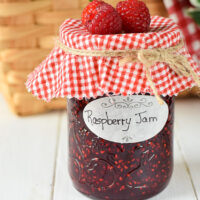
Traditional Raspberry Jam (no pectin added)
Ingredients
- 3 lbs fresh raspberries
- 2¼ lbs granulated sugar
- 6 tbsp bottled lemon juice
- 1 tsp butter
- Pinch salt (optional)
Instructions
-
Place raspberries in medium-sized stock pot and use a potato masher to coarsely mash down the berries. Add the sugar and stir to mix it in with the berries. Let mixture stand for about 30 minutes to allow the sugar to dissolve and the raspberries to begin releasing their juice.
-
Wash jars in hot soapy water. Rinse. Fill a large-sized pot about two-thirds full of hot tap water. Place the jars, upright, into the water. Ensure the jars are fully submerged, each jar filled with water, and that the water is at least an inch over the tops of the jars, adding more if necessary. Cover, bring to a boil, and boil gently for 10 minutes. Turn off heat and leave the jars in the hot water to have ready to fill once the jam finishes cooking.
-
Fill the canner about half full of hot tap water. Cover and bring to a boil to have it ready for processing of the filled jars.
-
While the jars are sterilizing and the water in the canner is heating, begin making the jam. Add the lemon juice, butter, and salt to the raspberry-sugar mixture and bring to a boil over medium heat. Stir mixture frequently to prevent scorching. Maintain a steady gentle boil (reducing heat slightly if jam boils too rapidly), until mixture reads 220°F, on a candy thermometer (See Note 1 below for alternative testing method of jam’s setting point). Skim off and discard any foam that surfaces as the jam cooks. When jam has reached 220°F, remove stockpot from heat and, using a spoon, skim off and discard any residual foam.
-
Use jar lifter tongs to carefully remove the hot sterilized jars from the water, one at a time, emptying the water from the jars back into the pot. Drain jars well.
-
Using a ladle, or a heat-proof glass measuring cup, and a wide-mouthed canning funnel, pour jam into the hot sterilized jars, leaving about ¼” headroom in each jar to allow for expansion during the hot water processing. Remove any trapped air bubbles in the jars with a chopstick or small heatproof, non-metallic spatula. Wipe the jar rims with a clean damp cloth to remove any stickiness or jam particles that could prevent the lids from sealing properly to the jars.
-
Remove a small amount of the hot water from the stockpot in which the jars were sterilized and place in small saucepan over simmering heat. Place the lids in the hot water to soften the rubber sealing compound. Do not boil the lids.
-
Using a magnetic lid lifter, remove lids from the hot water and center the heated lids on jars so the sealing compound on the lid edges aligns with the jar rims. Fingertip tighten ring/screw bands on jars until resistance is encountered. Do not over-tighten.
-
Using jar lifter tongs, carefully place filled jars upright in wire basket positioned in the canner, ensuring jars do not touch each other or fall over. Depending on the canner basket shape and design, it may be necessary to add one or more of the hot empty jars, upright, to the basket to fill up space so the filled jars do not topple over. Let the empty jars fill with water from the canner as they are submerged. Ensure the water level is at least 1” above the tops of jars, adding more boiling water as necessary. Cover with canner lid. Increase the heat to return the water to a full rolling boil then decrease the heat to just keep the water at a moderately rolling boil but not boiling over. Process jars in the hot water bath for 10 minutes, adjusting time as and if necessary for altitude. Start timing the processing from the point at which a full rolling boil is reached after jars have been added to the canner. At the end of the processing time, turn off heat and remove canner lid.
-
Let jars sit in the hot water for 5 minutes then, using jar lifter tongs, carefully remove the jars filled with jam, one at a time, and transfer them to a heat-proof cutting board, that has been covered with a towel, to cool completely. Listen for the “pop” or “ping” sound as the bottles seal over the next few minutes or hours. The lids of properly sealed jars will curve downward. Let jars rest, undisturbed, on counter for 24 hours. Then, test each jar for proper sealing by lightly pressing down on the center of each jar lid. If the lid is already pressed downward, and does not pop back up, it is properly sealed. Any jars that do not pass this test should be refrigerated and the jam used within a week or so. Store properly sealed jam bottles in cool, dark place. Refrigerate jam once jar has been opened.
Recipe Notes
Yield: Apx. 6 half-pint bottles
NOTE 1: If a candy thermometer is not available, place 2-3 freezer-safe saucers in freezer. To determine if jam is set, place a small amount of jam on chilled saucer and slightly ‘tilt and swirl’ saucer around to distribute the jam. Let jam sit, untouched, for about a minute, then gently push your finger through the jam. If the jam holds its shape (i.e., does not immediately run back together after the finger has been removed from the jam), it is set and ready to bottle. If not, continue to cook mixture, repeating the “chill” test about every 3 minutes or so (always removing the pot from the heat while conducting the chill test) until the jam passes the “chill” test.
Copyright My Island Bistro Kitchen 2023